Ferdinando II de' Medici, Grand Duke of Tuscany facts for kids
Quick facts for kids Ferdinando II |
|||||
|---|---|---|---|---|---|

Ferdinando II de' Medici in Coronation Robes by Justus Sustermans.
|
|||||
| Grand Duke of Tuscany | |||||
| Reign | 28 February 1621 – 23 May 1670 | ||||
| Predecessor | Cosimo II | ||||
| Successor | Cosimo III | ||||
| Born | 14 July 1610 Pitti Palace, Florence |
||||
| Died | 23 May 1670 (aged 59) Pitti Palace, Florence |
||||
| Spouse | |||||
| Issue Detail |
Cosimo III, Grand Duke of Tuscany Francesco Maria, Duke of Rovere |
||||
|
|||||
| House | House of Medici | ||||
| Father | Cosimo II de' Medici | ||||
| Mother | Maria Maddalena of Austria | ||||
| Religion | Roman Catholicism | ||||
Ferdinando II de' Medici (born 14 July 1610, died 23 May 1670) was the Grand Duke of Tuscany. He ruled from 1621 until his death in 1670. Ferdinando was the oldest son of Cosimo II de' Medici and Maria Maddalena of Austria.
People at the time remembered him as a person who loved culture and science. He was very involved with the Accademia del Cimento. This was the first scientific society in Italy, started by his younger brother, Leopoldo de' Medici. Ferdinando's long rule of 49 years saw the start of Tuscany's economic problems. He married Vittoria della Rovere, and they had two children who grew up: Cosimo III and Francesco Maria de' Medici, Duke of Rovere and Montefeltro.
Contents
Ferdinando's Rule as Grand Duke
Ferdinando was only 10 years old when his father, Cosimo II, passed away. Because he was so young, his mother, Maria Maddalena, and his grandmother, Christina of Lorraine, ruled Tuscany together. They were called regents.
In 1633, his regents arranged for him to marry Vittoria della Rovere. She was the granddaughter of the last Duke of Urbino. They hoped to gain the Duchy of Urbino through this marriage. However, they were not strong enough politically, and the Papal states took over Urbino instead.
When Ferdinando was 17, he traveled around Europe. He visited cities like Rome, Venice, and Prague. One year later, his regency ended, and he began to rule on his own. However, his grandmother, Christina, still had a lot of power until she died in 1636.
Ferdinando and Vittoria had two children who survived to adulthood. Their first son, Cosimo, was born in 1642. Their second son, Francesco Maria, was born in 1660.
A big challenge during Ferdinando's rule was an outbreak of the plague in 1630. This disease spread through Florence and caused many deaths. Unlike other rich people, Ferdinando and his brothers stayed in the city. They walked through the streets to help and encourage the people.
Tuscany also took part in the Wars of Castro. This was the last time Tuscany was involved in a military fight. In 1643, they defeated the forces of Pope Urban VIII. After this war, Tuscany's treasury was very low on money. The economy became so weak that people in the countryside started using barter trade. This means they traded goods directly instead of using money.
Ferdinando died on 23 May 1670. He was buried in the Basilica of San Lorenzo in Florence. This was the traditional burial place for the Medici family.
Ferdinando's Love for Science
Ferdinando was very interested in new technology. He had many scientific tools in the Palazzo Pitti, his palace. These included hygrometers (to measure humidity), barometers (to measure air pressure), thermometers (to measure temperature), and telescopes.
In 1654, he is said to have invented the sealed-glass thermometer. This was a tube filled with colored alcohol. Small glass bubbles inside would move up or down as the temperature changed. This type of thermometer was called a "Florentine thermometer."
In 1657, Ferdinando's youngest brother, Leopoldo de' Medici, started the Accademia del Cimento. This group brought scientists from all over Tuscany to Florence. They worked together to study and experiment.
Ferdinando was a supporter and friend of the famous scientist Galileo Galilei. Galileo even dedicated one of his important books, Dialogue Concerning the Two Chief World Systems, to Ferdinando. This book led to Galileo facing questions from the Inquisition, a religious court.
Ferdinando tried to help Galileo and keep him in Florence. However, the Roman Inquisitors insisted that Galileo come to Rome. In 1633, Galileo was found guilty of "suspicion of heresy." He was sentenced to house arrest. Ferdinando later visited Galileo at his home, where the elderly scientist lived out his life.
| Styles of Ferdinando II de' Medici, Grand Duke of Tuscany |
|
|---|---|
 |
|
| Reference style | His Highness |
| Spoken style | Your Highness |
Ferdinando's Children
Ferdinando II had four children with Vittoria della Rovere. Only two of them lived to be adults:
- Cosimo, Grand-Prince of Tuscany (born and died in 1639)
- A daughter who died at birth (1640)
- Cosimo III (born 14 August 1642 – died 31 October 1723). He became Grand Duke of Tuscany after his father. He married Marguerite Louise d'Orléans and had children.
- Francesco Maria (born 12 November 1660 – died 3 February 1711). He became Duke of Rovere and Montefeltro. He married Eleonora Luisa Gonzaga but had no children.
See also
 In Spanish: Fernando II de Médici para niños
In Spanish: Fernando II de Médici para niños




